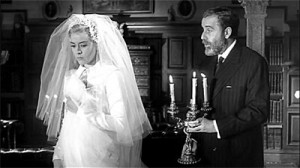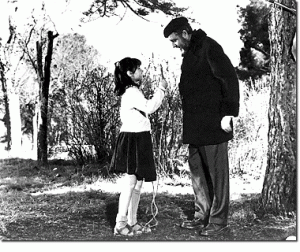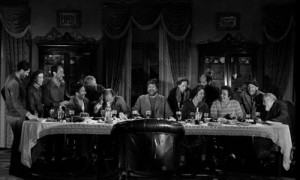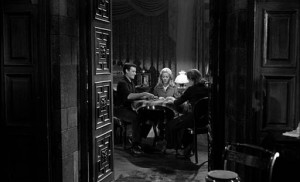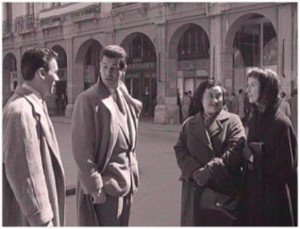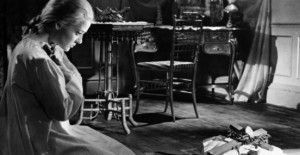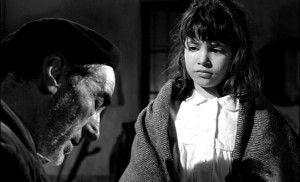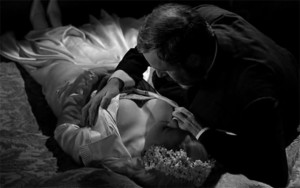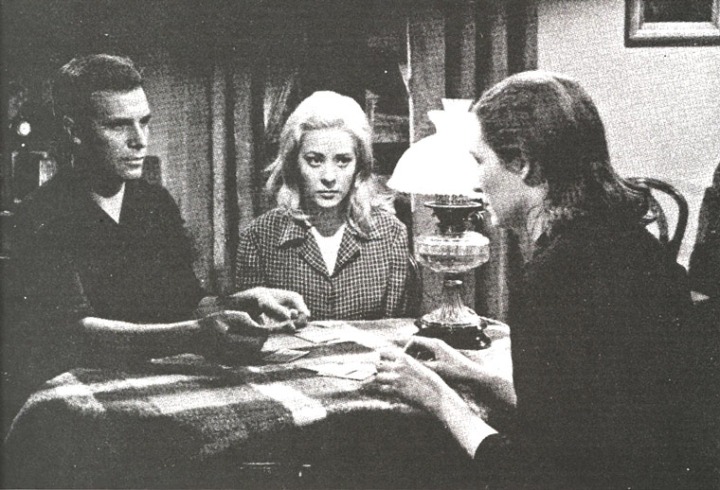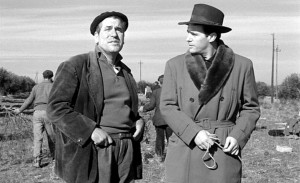From Cineaste, Vol. XXXI, No. 4, September 2006. — J.R.
Spoilers ahead: The title heroine (Silvia Pinal) of
Luis Buñuel’s masterpiece, a Spanish novice
about to take her final vows, is ordered by her
mother superior to visit her rich uncle (Fernando
Rey), Don Jaime, who’s been supporting her over
the years but whom she barely knows. A
necrophiliac foot fetishist, he’s preoccupied with
how closely his beautiful niece resembles his
late wife, who died tragically on their wedding night,
and somehow manages to persuade Viridiana
to put on her wedding dress, which he’s
faithfully preserved. With the help of his servant
Ramona (Margarita Lozano), he then drugs her with the
intention of raping her, but deeply mortified by
his behavior, ultimately holds back and hangs
himself instead, using the skipping-rope he
previously gave to Ramona’s little girl.
If this opening strongly evokes the horror of a
Gothic novel — a form of literature Luis Buñuel
was especially drawn to — it takes on
further dimensions just after this suicide, an outcome
already complicated by the fact that Don Jaime,
no simple villain and highly principled, is shown rather
sympathetically. Believing herself to have been
ravaged, Viridiana renounces her vows without
losing any of her faith and piety, and inheriting
Dion Jaime’s estate, decides to take in local beggars
as an act of charity. Their responses to her
generosity are mainly venal, and they immediately start
treating one another with scorn and envy. One of them
takes over the skipping rope as a belt to hold up his
trousers —- an emblematic example of how Buñuel
imbues his universe with a sense of ironic relativity.
Meanwhile, Don Jaime’s illegitimate son Jorge
(Francisco Rabel) arrives as co-heir, hoping to improve the
neglected property and meanwhile sharing the house with
Viridiana and the beggars. He has a mistress in tow, but
she quickly departs after deciding he’s more interested in
his cousin. Then, when Viridiana and Jorge go off on a day
trip, the beggars throw a raucous party and have an
orgiastic feast, at one point briefly duplicating in their
stances and gestures the figures in Leonardo Da Vinci’s
Last Supper. When Viridiana and Jorge return, another
attempt to rape her by one of the beggars is only averted
by Jorge’s offer of a bribe. In a teasingly ambiguous
finale, Viridiana is later seen participating in a threeway
card game with Jorge and Ramona.
***
It’s seldom recognized that Viridiana (1961) is the first feature Buñuel ever
directed in his native Spain — and only the second film he directed there
after his half-hour documentary Las Hurdes almost three decades earlier.
Given all his years of exile in the U.S. and Mexico, this re-establishing of
his roots is an important aspect of what enabled him to reinvent himself
afterwards as an international arthouse icon. “For us,” said Pere
Portabella, one of the film’s two Spanish executive producers, in a
1999 interview, “Buñuel was the only solid reference point in our
cinema.” And insofar as he was the most Spanish of Spanish filmmakers,
this particular context is worth stressing.
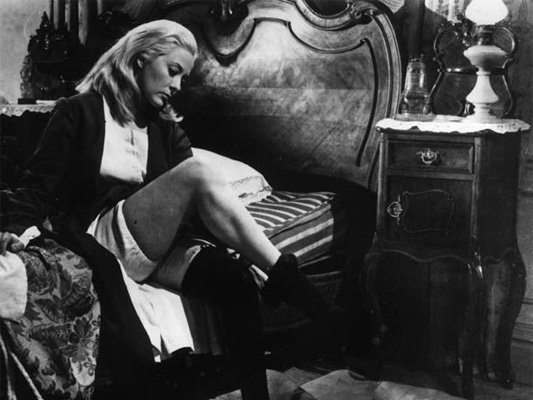
It isn’t stressed on Criterion’s otherwise excellent DVD of Viridiana,
which doesn’t mention Portabella — in my view, another important
Spanish filmmaker, quite apart from his producing — either in the extras
or in the accompanying booklet. (By contrast, he was mentioned twice
in a brief production story about Viridiana in the Spring 1961 issue
of Sight and Sound, which also cited his then-recent work with
Carlos Saura and Marco Ferreri.) But then again our overall sense of
Buñuel’s history tends to be rather spotty, and our sense of Spanish
cinema under Franco is almost nonexistent. A dictatorship which
caused time to freeze and a closed society to remain insulated
helped to sustain our ignorance about the country for decades, and
Buñuel’s fractured career has also been subject to certain capitalist
forms of censorship. Most readers of his autobiography in English
translation — titled My Last Sigh when “My Last Gasp” would be
more appropriate — are unaware that unacknowledged excisions in
the text have been made on practically every page, apparently on the
assumption that us Yanks wouldn’t care or be interested. (I once went
to the trouble of photocopying the French version so I could start to
glean all I’d been missing.)
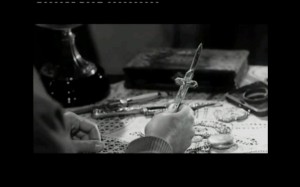
Spanish cinema under Franco has become such a closed book
to us that notable acts of witness as well as resistance to its
repressions have often been ignored or misread, with Buñuel
sometimes perversely used as an instrument of —- or alibi for
—- our own repression. Having recently made a belated
discovery of two remarkable (if currently unfashionable)
features by Juan Antonio Bardem (1922-2002), Death of
a Cyclist (1955) and Calle Mayor (1956) —- both forthright
antifascist films that, in the tradition of Clouzot’s Le Corbeau
(1943), take the shape of displaced allegories out of necessity,
exposing the ugliness, cruelty, and brutality of fascism’s social
effects as reflected in male-female relationships —- I was shocked
to find them both dismissed in David Thomson’s A
Biographical Dictionary of the Cinema as simple realist
melodramas. (Calle Mayor —- which evokes I Vitelloni to the
same degree that Cyclist evokes Cronaca di un amore — is
even misdescribed as an adaptation of Sinclair Lewis’s Main
Street, apparently on the basis of its English title, when a more
accurate reference point would be Neil LaBute’s In the
Company of Men, which arguably bears the same relation
to capitalism that Calle Mayor bears to fascism). But to get some
inkling of the difficulties Bardem faced while making it, check out
Betsy Blair’s The Memory of All That. Worst of all, Bardem —-
whose films have far more to tell us about Franco Spain than
Viridiana does —- is chastised by Thomson for not being Buñuel;
only one anti-Franco vision is permitted. Clearly some kinds of fascist
prohibition are contagious. But it would be bracing to see Criterion
defy them long enough to bring out a Bardem film or two on DVD.
[2011 postscript: Criterion has subsequently released a DVD of
Death of a Cyclist.]
In other words, the limitations in Criterion’s grasp of
Viridiana’s Spanish context are basically inherited ones —
the outgrowths of long-term and fairly widespread lazy habits.
And they’re both offset and to some extent underlined by the
DVD’s extras: fine interviews with Viridiana’s Mexican star
Pinal (whose husband became the film’s Mexican producer) and
Cineaste editor Richard Porton, and an equally informative 1964
documentary on Buñuel for the French TV series Cinéastes de
notre temps. (The menu claims that the latter is only “edited
excerpts,” though a comparison of running times suggests that the
only likely missing pieces are a few odd clips due to of clearance
problems.) Porton usefully links what he calls Viridiana’s religious
masochism with Buñuel’s earlier Nazarin and his subsequent
Simon of the Desert, thus opting for a certain thematic continuity
that downplays the distinction between the Mexico of these two films
and the Spain of Viridiana. (To be fair, however, he’s also attentive
to Buñuel’s links to Spanish Communists and the way in which Spain
offered him a way of redefining his Surrealism in more realistic
terms.)
Pinal, of course, offers a Mexican view of Buñuel while the
documentary offers an explicitly French one, with Georges
Sadoul among the interviewees. What seems missing from all
three of these approaches is a sense of how the seemingly
“timeless” medievalism of Franco Spain —- encompassing the
same sort of Quixotic nostalgia for feudalism that presumably
led Orson Welles to overlook his political scruples when he
chose to live and work there during the 50s and 60s —- may
have provided Buñuel with a more “universal” canvas for his
ironic parables than anything he could find in Mexico.
(Arguably, Robert Bresson profited from a similar medieval
ambience in rural France in Au Hasard Balthazar and
Mouchette a few years later.)
Admittedly, a helpful interview with Buñuel in Criterion’s
booklet is headlined “The Return to Spain,” and Michael
Wood’s notes, even if they don’t mention Las Hurdes, say
that Viridiana “did cause a tremendous stir” after winning
the Paume d’or at Cannes and that the film was banned in
Spain until 1977. (In 1961, the heads of at least two Franco
government officials rolled —- apparently the one who
approved the film getting made, whom Wood vaguely
mentions, and the one who accepted the award while
Buñuel craftily remained in Paris, whom Wood doesn’t
mention. But, citing Buñuel, Wood adds that Franco
himself, when he finally came to see the film, reportedly
found little to object to.) What the notes don’t say is to
my mind far more telling: that the film was denied
Spanish nationality by the Franco government after the
Cannes prize and that all its official papers were
confiscated and/or destroyed. “Viridiana simply did
not exist,” Portabella remarked in the 1999 interview.
“They did not prohibit it, they simply erased it….Eight
years later, the [censors], at a meeting on January 30,
1969, prohibited the exhibition of a Mexican film entitled
Viridiana. It was classified as: `Blasphemous,
antireligious. Cruel and contemptuous of the poor. Also
morbid and brutal. A poisonous film, caustic in its
cinematographic ability to combine images, references,
and music.’”
I’m far from being a specialist in these matters, and should
confess that some aspects of my slant on Viridiana derives
from recent correspondence with Portabella —- and that this
has derived in turn from my enthusiasm for his own films,
extending all the way from my excited first encounters with his
Vampir-Cuadecuc and Umbracle at the Directors Fortnight
in Cannes in 1971 and 1972 to my recent encounter with his 1989
Warsaw Bridge. (It’s an enthusiasm shared by Jonathan
Demme, among others.) Portabella couldn’t attend Cannes in
the 70s because his anti-Franco activities, including his work
on Viridiana, led to his passport being taken away for that entire
decade —- another illustration of how Franco Spain tended to
mask its own history.
I don’t speak Spanish, but a Cuban playwright friend who
recently resaw Viridiana told me he was amazed by the
absolute accuracy of all the dialects and accents given to each of
the characters in terms of class, profession, cultural
background, and region — a kind of precision that he found
unmatched in Buñuel’s subsequent Tristana, after his
encroaching deafness became worse, as well as in his
Mexican pictures, most of which were made earlier. Some
of this exactness gets conveyed even to those of us who don’t
know the language (although I’m told it helps to understand
the double entendres involving the “threesome” in the final
card-playing scene — Buñuel’s clever and suggestive way of
replacing a more obviously carnal finale of Viridiana forsaking
her chastity after the censors objected.) It’s part of the film’s
overall triumph of combining simplicity and directness with
so much moral ambiguity that no character is ever being set
up for simple scorn or admiration. This includes Viridiana,
Don Jaime, Ramona (the most ambiguous figure of all in
terms of her shifting alliances), Jorge, and even the beggars.
While Buñuel, possibly the cinema’s key master of political
incorrectness, is certainly interested in challenging his heroine’s sense
of virtue with the beggars’ orgy, he never stoops to scorn or ridicule.
When Robert Altman in M*A*S*H copied Buñuel’s Last Supper gag,
there’s some form of mockery that seemingly got added to the mix, but
it’s absent from the original, where nothing’s ever that simple, even
when it feels fairly elemental. And it’s no less characteristic of Buñuel,
an equal-employment humanist, to assign a humane protest against
the mistreatment of a dog not to Viridiana but to the acerbic
Jorge.
Postscript (from June 8, 2013): From Germany, Manfred Polak has emailed me, “The head of the Spanish Film Institute, who allowed it to be made (and helped to avoid the censors, who often were Catholic priests then), and who also accepted the prize in Cannes, was José María Muñoz Fontán. He and the other members of the Cannes delegation were sacked, when they were still on their way home, after the Vatican newspaper L’Osservatore Romano had stirred up the scandal.”


